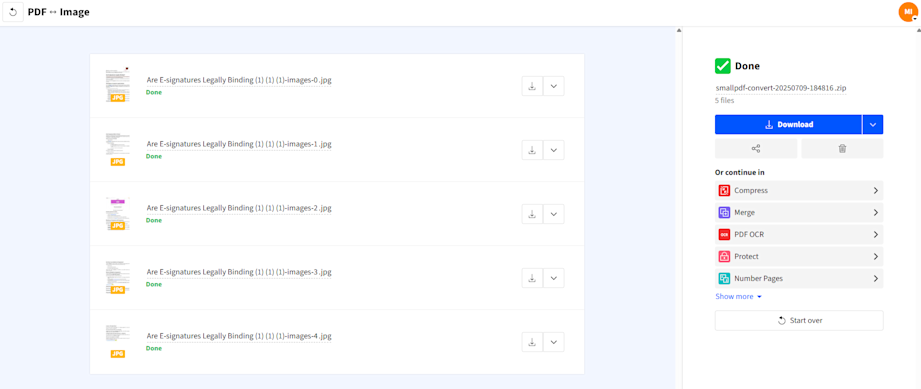Not sure if your PDF is high enough quality? Learn how to check DPI and fix low-resolution pages before printing or submitting.
Wondering whether your PDF will print sharply or end up looking blurry? DPI (dots per inch) is usually the reason, especially for scanned pages and image-based PDFs.
Text and vector elements don’t have a fixed DPI, so what really matters is the resolution of images at the size you plan to print. In this guide, we’ll show you how to check the DPI of a PDF, what the numbers actually mean, and how to fix low-resolution pages using Smallpdf and simple built-in tools.
Quick Steps: Check DPI Fast
If you need a quick answer, this method gives you a real number you can trust.
- Open Smallpdf PDF to JPG and upload your PDF.
- Convert entire pages to images, then download the output.
- Check the downloaded image’s DPI in your device’s file info or inspector.
Most Reliable Ways to Check DPI
PDFs don’t always store the DPI in a clean, visible label. These approaches work because they measure the pixels you actually have.
- Convert the page to an image, then read the DPI or pixel dimensions.
- On Mac, use Preview’s Inspector to view image resolution details.
- For technical workflows, extract image data using command-line tools.
If you’re checking print quality, aim for a result that supports your print size. A common baseline is 300 DPI for crisp text and logos in print, but your required DPI depends on the job and the viewing distance.
Method 1: Convert PDF to Images, Then Check DPI
This is the easiest method to explain, repeat, and document for clients. It works because Smallpdf converts PDF pages into image files you can inspect like any other photo.
Step 1: Convert the PDF With Smallpdf PDF to JPG
Open Smallpdf PDF to JPG, then upload your PDF from your device.
Step 2: Choose the Right Conversion Output
Pick “Convert entire pages” if you’re checking a scanned document or a full-page design. Pick “Extract single images” if you only care about embedded photos or graphics.

Convert the PDF to an image so you can check the DPI
Step 3: Download and Check Resolution
After download, check the image details:
- Windows: Right-click the JPG, then click “Properties” > “Details” and look for horizontal and vertical resolution.
- Mac: Open the image in Preview, then use the Inspector to view resolution.

Check the DPI on the image on Windows
If your system shows pixel dimensions instead of DPI, use this quick math:
Effective DPI = pixel width ÷ printed width (in inches)
Example: 2550 px wide printed at 8.5 inches is 300 DPI.
Step 4: Match the Number to Your Print Size
A page can have high pixel dimensions but still print soft if it’s stretched too large. Always compare DPI to the intended size on paper, not just the number in metadata.
Method 2: Check Resolution on Mac With Preview
If you’re on a Mac, Preview’s Inspector is a clean way to view resolution details for PDFs and images.
- Open the PDF in Preview.
- Click the Inspector button, then review the details shown for the document or image content.
If Preview doesn’t show a clear DPI value for the exact element you care about, use Method 1. Converting to an image makes the resolution measurable every time.
Method 3: Check DPI on Mobile
Mobile apps can be inconsistent for DPI. Some show basic file details, but many don’t surface the true resolution for PDF content.
The most reliable mobile workflow is still conversion first:
- Open PDF to JPG in your mobile browser.
- Upload your PDF and convert entire pages.
- Download the JPGs, then check image info in your Photos or Files app.
This approach keeps the steps the same across iOS and Android, and it gives you an image file that most phones can inspect.
Method 4: Advanced Checks for Power Users
If you process lots of PDFs or need a repeatable audit trail, command-line inspection can help. Keep this section for technical workflows, not casual checks.
A common approach is to extract embedded image data (width, height, and resolution) using utilities like Poppler’s pdfimages -list. If you see pixel dimensions but no DPI, you can still calculate effective DPI using the print-size formula from Method 1.
Tool Comparison: Which Method Should You Use?
Here’s a quick way to choose based on your situation.

Methods to check the DPI of a PDF
What to Do If the DPI Info Is Missing
Some files simply don’t store DPI in a way your viewer shows. In that case, focus on what you can measure.
- Convert the page to a JPG and use pixel dimensions to calculate effective DPI.
- Run a Zoom test, but treat it as a hint, not a verdict. If an image falls apart quickly at high zoom, it’s likely low resolution.
- If this came from a scan, assume the scanner setting matters more than the PDF label.
DPI is only one part of quality. Compression and sharpening can change how “clean” an image looks, even if the math is fine.
What to Do If Your DPI Is Too Low
You can’t magically create detail that wasn’t captured. The goal is to replace or rebuild the low-resolution parts.
Rescan or Re-export From the Source
If the PDF comes from scanning, rescan at a higher setting, then recreate the PDF. Scans are the most common reason print files look soft.
Replace Low-Res Images Before Rebuilding the PDF
If a single image is the problem, swap it with a higher-resolution version, then rebuild the PDF.
A practical Smallpdf workflow: 1. Convert the PDF to images to identify the weak pages. 2. Replace or enhance the source image outside the PDF. 3. Convert images back into a PDF using JPG to PDF flow, then merge pages if needed.
Be Careful With Compression
Compression helps with upload limits, but strong compression can reduce image detail. If print quality matters, keep compression conservative and review results before submitting.
Privacy Notes for DPI Checks
If you’re checking client documents, privacy matters. Smallpdf uses a secure connection, deletes files automatically after one hour for most processes, and follows widely used security and privacy standards like ISO 27001 and GDPR.
Check PDF DPI Quickly With Smallpdf
If you need a fast, repeatable way to confirm print quality, converting pages with Smallpdf PDF to JPG is the simplest route.
You get measurable image output, you can calculate effective DPI for your print size, and you can fix problems before you submit the file.
Frequently Asked Questions
How do I check DPI of a PDF?
Convert the PDF to JPG with Smallpdf, download the image, then read the DPI or pixel dimensions in your file info and calculate effective DPI for your print size.
How do I make sure my PDF is 300 DPI?
Start from a high-resolution source. If it’s a scan, rescan at a higher setting. If it’s a design, export using print-quality settings. Then confirm by converting a page to JPG and checking the effective DPI.
Why does my PDF look fine on screen but print blurry?
Screens hide low resolution because they’re smaller and backlit. Printing reveals the real detail. Check effective DPI at the size you’re printing.
Does a PDF always have a DPI value?
No. Text and vectors don’t have fixed DPI. DPI mainly applies to embedded images and scanned pages.
Can I check DPI on my phone?
Yes, but the most consistent method is converting the page to an image with Smallpdf PDF to JPG, then checking the image info on your device.



